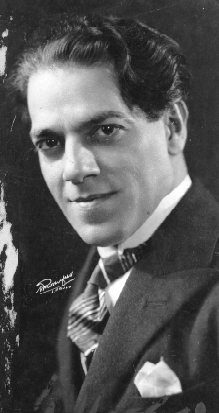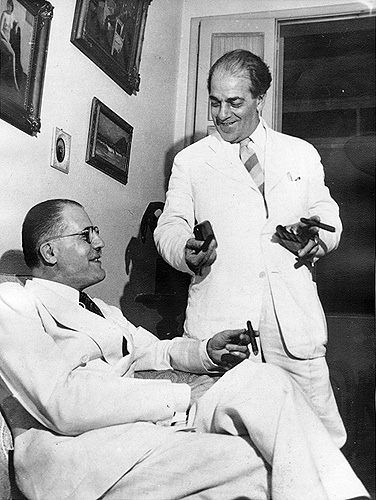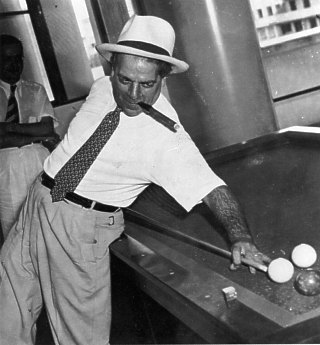<Back to Index>
- Mathematician William Oughtred, 1574
- Composer Heitor Villa-Lobos, 1887
- Founder of Detroit Antoine Laumet de La Mothe, sieur de Cadillac, 1658
PAGE SPONSOR



Heitor Villa-Lobos (March 5, 1887 – November 17, 1959) was a Brazilian composer, described as "the single most significant creative figure in 20th-century Brazilian art music". Villa-Lobos has become the best-known and most significant Latin American composer to date. He wrote numerous orchestral, chamber, instrumental and vocal works. His music was influenced by both Brazilian folk music and by stylistic elements from the European classical tradition, as exemplified by his Bachianas Brasileiras ("Brazilian Bach-pieces").
Heitor Villa-Lobos was born in Rio de Janeiro. His father, Raul, was a wealthy, educated man of Spanish extraction, a librarian, an amateur astronomer and musician. In Villa-Lobos's early childhood, Brazil underwent a period of social revolution and modernisation, finally abolishing slavery in 1888 and overthrowing the Empire of Brazil in 1889. The changes in Brazil were reflected in its musical life: previously European music had been the dominant influence, and the courses at the Conservatório de Música were grounded in traditional counterpoint and harmony. Villa-Lobos underwent very little of this formal training. After a few abortive harmony lessons, he learnt music by illicit observation from the top of the stairs of the regular musical evenings at his house arranged by his father. He learned to play the cello, the guitar and the clarinet. When his father died suddenly in 1899 he earned a living for his family by playing in cinema and theatre orchestras in Rio.
Around 1905 Villa-Lobos started explorations of Brazil's "dark interior", absorbing the native Brazilian musical culture. Serious doubt has been cast on some of Villa-Lobos's tales of the decade or so he spent on these expeditions, and about his capture and near escape from cannibals, with some believing them to be fabrications or wildly embellished romanticism. After this period, he gave up any idea of conventional training and instead absorbed the influences of Brazil's indigenous cultures, itself based on Portuguese, African, and American Indian elements. His earliest compositions were the result of improvisations on the guitar from this period.
Villa-Lobos played with many local Brazilian street-music bands; he was also influenced by the cinema and Ernesto Nazareth's improvised tangos and polkas. For a time Villa-Lobos became a cellist in a Rio opera company, and his early compositions include attempts at Grand Opera. Encouraged by Arthur Napoleão, a pianist and music publisher, he decided to compose seriously. In
1912, Villa-Lobos married the pianist Lucília Guimarães,
ended his travels, and began his career as a serious musician. His
music began to be published in 1913. He introduced some of his
compositions in a series of occasional chamber concerts (later also
orchestral concerts) from 1915 – 1921, mainly in Rio de Janeiro's Salão Nobre do Jornal do Comércio. The
music presented at these concerts shows his coming to terms with the
conflicting elements in his experience, and overcoming a crisis of
identity, as to whether European or Brazilian music would dominate his
style. This was decided by 1916, the year in which he composed the symphonic poems Amazonas and Uirapurú (although Amazonas was not performed until 1929, and Uirapurú was first performed in 1935). These works drew from native Brazilian legends and the use of "primitive", folk material. European influence did still inspire Villa-Lobos. In 1917 Sergei Diaghilev made an impact on tour in Brazil with his Ballets Russes. That year Villa-Lobos also met the French composer Darius Milhaud, who was in Rio as secretary to Paul Claudel at the French Legation. Milhaud brought the music of Debussy, Satie, and possibly Stravinsky; in return Villa-Lobos introduced Milhaud to Brazilian street music. In 1918, he also met the pianist Artur Rubinstein, who became a lifelong friend and champion; this meeting prompted Villa-Lobos to write more piano music. In about 1918 Villa-Lobos abandoned the use of opus numbers for his compositions as a constraint to his pioneering spirit. With the suite Carnaval das crianças ("Children's carnival") for two pianos of 1919–20, Villa-Lobos liberated his style altogether from European Romanticism. The piece depicts eight characters or scenes from Rio's Lent Carnival. In February 1922, a festival of modern art took place in São Paulo and
Villa-Lobos contributed performances of his own works. The press were
unsympathetic and the audience were not appreciative; their mockery was
encouraged by Villa-Lobos's being forced by a foot infection to wear
one carpet slipper. The festival ended with Villa-Lobos's Quarteto simbólico, composed as an impression of Brazilian urban life. In July 1922, Rubinstein gave the first performance of A Prole do Bebê. There had recently been an attempted military coup on Copacabana Beach,
and places of entertainment had been closed for days; the public
possibly wanted something less intellectually demanding, and the piece
was booed. Villa-Lobos was philosophical about it, and Rubinstein later
reminisced that the composer said, "I am still too good for them." The
piece has been called "the first enduring work of Brazilian modernism". Rubinstein suggested that Villa-Lobos tour abroad, and in 1923 he set out for Paris.
His avowed aim was to exhibit his exotic sound world rather than to
study. Just before he left he completed his Nonet (for ten players and
chorus) which was first performed after his arrival in the French
capital. He stayed in Paris in 1923–24 and 1927–30, and there he met
such luminaries as Edgard Varèse, Pablo Picasso, Leopold Stokowski and Aaron Copland. Parisian concerts of his music made a strong impression. In the 1920s, Villa-Lobos also met the Spanish guitarist Andrés Segovia, who commissioned a guitar study: the composer responded with a set of 12 (Douze Études), each taking a tiny detail or figure from Brazilian chorões (itinerant
street musicians) and transforming it into a piece that is not merely
didactic. The chorões were also the initial inspiration behind
his series of compositions, the Chôros, which were written between 1924–29. The first European performance of Chôros no. 10, in Paris, caused a storm: L. Chevallier wrote of it in Le Monde musicale, "[…it is] an art […] to which we must now give a new name." In
1930, Villa-Lobos, who was in Brazil to conduct, planned to return to
Paris. One of the consequences of the revolution of that year was that
money could no longer be taken out of the country, and so he had no
means of paying any rents abroad. Thus forced to stay in Brazil, he
arranged concerts instead around São Paulo, and composed
patriotic and educational music. In 1932, he became director of the
Superindendência de Educação Musical e Artistica
(SEMA), and his duties included arranging concerts including the
Brazilian premieres of Ludwig van Beethoven's Missa Solemnis and Johann Sebastian Bach's B Minor Mass as
well as Brazilian compositions. His position at SEMA led him to compose
mainly patriotic and propagandist works. His series of Bachianas Brasileiras were a notable exception. In
1936, at the age of forty-nine, Villa-Lobos left his wife, and became
romantically involved with Arminda Neves d’Almeida, who remained his
companion until death. Almeida eventually took on the name Villa-Lobos,
though Villa-Lobos never divorced his first wife. After Villa-Lobos'
death, Arminda became the Director of the Museu Villa-Lobos in 1960,
until her death in 1985. Arminda was herself a musician and a
significant influence on Villa-Lobos. He also dedicated a good number
of works to her, including the Ciclo brasileiro and many of the Chôros. Villa-Lobos's writings of the Vargas era include propaganda for Brazilian nationhood ("brasilidade"), and teaching and theoretical works. His Guia Prático ran to 11 volumes, Solfejos (two volumes, 1942 and 1946) contained vocal exercises, and Canto Orfeônico (1940 and 1950) contained patriotic songs for schools and for civic occasions. His music for the film O Descobrimento do Brasil ("The Discovery of Brazil") of 1936, which included versions of earlier compositions, was arranged into orchestral suites, and includes a depiction of the first mass in Brazil in a setting for double choir. Villa-Lobos published A Música Nacionalista no Govêrno Getúlio Vargas ca.
1941, in which he characterised the nation as a sacred entity whose
symbols (including its flag, motto and national anthem) were
inviolable. Villa-Lobos was the chair of a committee whose task was to
define a definitive version of the Brazilian national anthem. After 1937, during the Estado Novo period
when Vargas seized power by decree, Villa-Lobos continued producing
patriotic works directly accessible to mass audiences. Independence Day
on September 7, 1939 involved 30 000 children singing the national
anthem and items arranged by Villa-Lobos. For the 1943 celebrations he
also composed the ballet Dança da terra, which the authorities deemed unsuitable until it was revised. The 1943 celebrations did include Villa-Lobos's hymn Invocação em defesa da pátria shortly after Brazil's declaring war on Germany and its allies. Villa-Lobos's demagogue status damaged his reputation among certain schools of musicians, among them disciples of new European trends such as serialism
—
which was effectively off limits in Brazil until the 1960s. This crisis
was, in part, due to some Brazilian composers finding it necessary to
reconcile Villa-Lobos's own liberation of Brazilian music from European
models in the 1920s with a style of music they felt to be more
universal. Vargas fell from power in 1945. Villa-Lobos was able, after the end of the war, to travel abroad again; he returned to Paris, and also made regular visits to the United States as well as travelling to Great Britain, and Israel. He received a huge number of commissions, and fulfilled many of them despite failing health. He composed concertos for piano, cello (the second one in 1953), classical guitar (in 1951 for Segovia, who refused to play it until the composer provided a cadenza in 1956), harp (for Nicanor Zabaleta in 1953) and harmonica (for John Sebastian, Sr. in 1955–6). Other commissions included his Symphony no. 11 (for the Boston Symphony Orchestra in 1955), and the opera Yerma (1955–56) based on the play by Federico García Lorca. His prolific output of this period prompted criticisms of note spinning and banality: critical reactions to his Piano Concerto No. 5 included the comments "bankrupt" and "piano tuners' orgy". His music for the film Green Mansions starring Audrey Hepburn and Anthony Perkins, commissioned by MGM in 1958, earned Villa-Lobos $25,000, and he conducted the soundtrack recording himself. The film was in production for many years. Originally to be directed by Vincente Minnelli, it was taken over by Hepburn's husband Mel Ferrer. MGM decided only to use part of Villa-Lobos's music in the actual film, turning instead to Bronislaw Kaper for the rest of the music. From the score, Villa-Lobos compiled a work for soprano soloist, male chorus, and orchestra, which he titled Forest of the Amazons and recorded it in 1959 in stereo with Brazilian soprano Bidu Sayão, an unidentified male chorus, and the Symphony of the Air for United Artists Records. The spectacular recording was issued both on LP and reel-to-reel tape. In
June 1959, Villa-Lobos alienated many of his fellow musicians by
expressing disillusionment, saying in an interview that Brazil was "dominated by mediocrity". In November he died in Rio; his state funeral was the final major civic event in that city before the capital transferred to Brasília. He is buried in the Cemitério São João Batista in Rio de Janeiro.